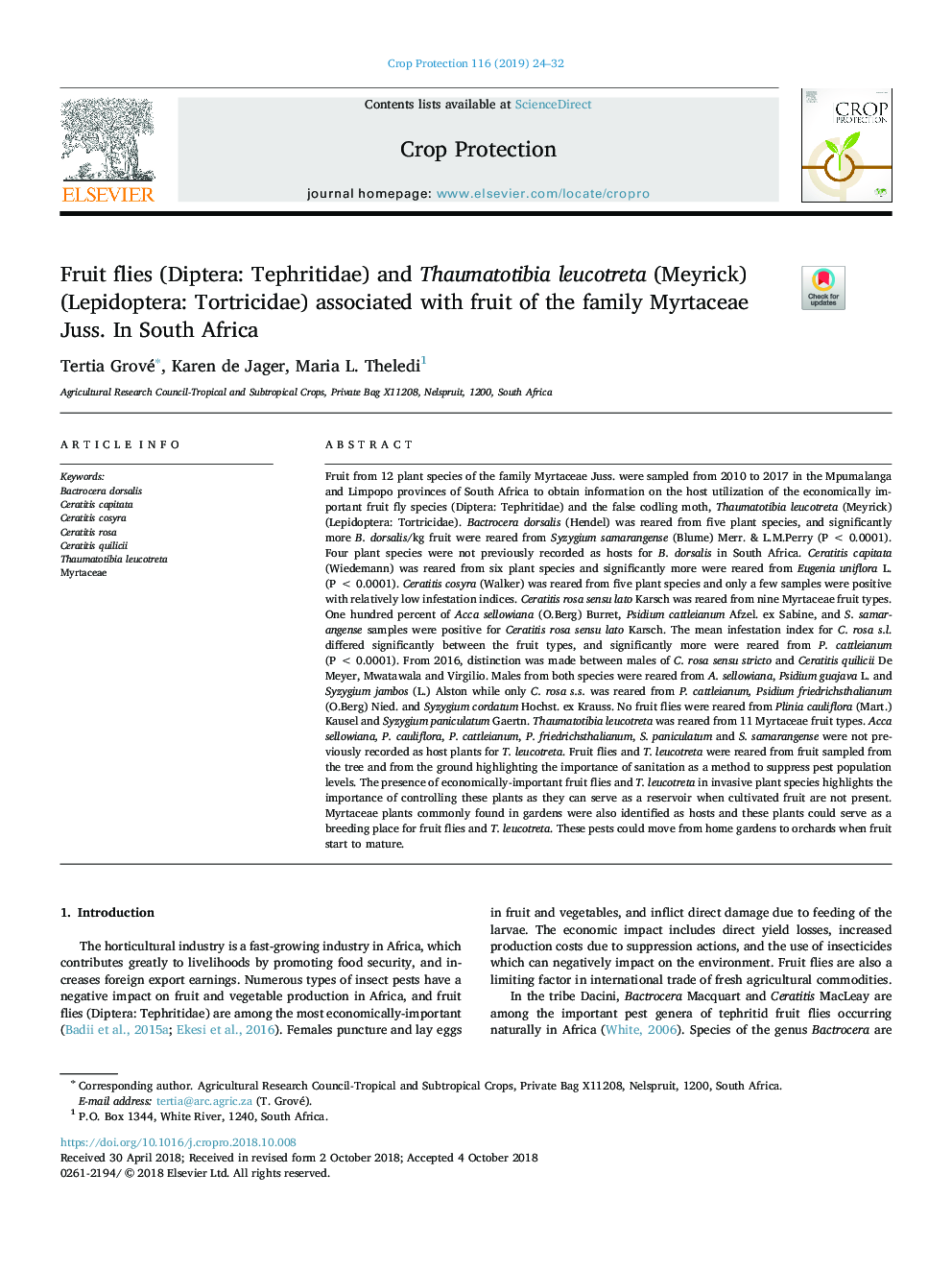| کد مقاله | کد نشریه | سال انتشار | مقاله انگلیسی | نسخه تمام متن |
|---|---|---|---|---|
| 11013006 | 1797617 | 2019 | 9 صفحه PDF | دانلود رایگان |
عنوان انگلیسی مقاله ISI
Fruit flies (Diptera: Tephritidae) and Thaumatotibia leucotreta (Meyrick) (Lepidoptera: Tortricidae) associated with fruit of the family Myrtaceae Juss. In South Africa
دانلود مقاله + سفارش ترجمه
دانلود مقاله ISI انگلیسی
رایگان برای ایرانیان
موضوعات مرتبط
علوم زیستی و بیوفناوری
علوم کشاورزی و بیولوژیک
علوم زراعت و اصلاح نباتات
پیش نمایش صفحه اول مقاله

چکیده انگلیسی
Fruit from 12 plant species of the family Myrtaceae Juss. were sampled from 2010 to 2017 in the Mpumalanga and Limpopo provinces of South Africa to obtain information on the host utilization of the economically important fruit fly species (Diptera: Tephritidae) and the false codling moth, Thaumatotibia leucotreta (Meyrick) (Lepidoptera: Tortricidae). Bactrocera dorsalis (Hendel) was reared from five plant species, and significantly more B. dorsalis/kg fruit were reared from Syzygium samarangense (Blume) Merr. & L.M.Perry (Pâ¯<â¯0.0001). Four plant species were not previously recorded as hosts for B. dorsalis in South Africa. Ceratitis capitata (Wiedemann) was reared from six plant species and significantly more were reared from Eugenia uniflora L. (Pâ¯<â¯0.0001). Ceratitis cosyra (Walker) was reared from five plant species and only a few samples were positive with relatively low infestation indices. Ceratitis rosa sensu lato Karsch was reared from nine Myrtaceae fruit types. One hundred percent of Acca sellowiana (O.Berg) Burret, Psidium cattleianum Afzel. ex Sabine, and S. samarangense samples were positive for Ceratitis rosa sensu lato Karsch. The mean infestation index for C. rosa s.l. differed significantly between the fruit types, and significantly more were reared from P. cattleianum (Pâ¯<â¯0.0001). From 2016, distinction was made between males of C. rosa sensu stricto and Ceratitis quilicii De Meyer, Mwatawala and Virgilio. Males from both species were reared from A. sellowiana, Psidium guajava L. and Syzygium jambos (L.) Alston while only C. rosa s.s. was reared from P. cattleianum, Psidium friedrichsthalianum (O.Berg) Nied. and Syzygium cordatum Hochst. ex Krauss. No fruit flies were reared from Plinia cauliflora (Mart.) Kausel and Syzygium paniculatum Gaertn. Thaumatotibia leucotreta was reared from 11 Myrtaceae fruit types. Acca sellowiana, P. cauliflora, P. cattleianum, P. friedrichsthalianum, S. paniculatum and S. samarangense were not previously recorded as host plants for T. leucotreta. Fruit flies and T. leucotreta were reared from fruit sampled from the tree and from the ground highlighting the importance of sanitation as a method to suppress pest population levels. The presence of economically-important fruit flies and T. leucotreta in invasive plant species highlights the importance of controlling these plants as they can serve as a reservoir when cultivated fruit are not present. Myrtaceae plants commonly found in gardens were also identified as hosts and these plants could serve as a breeding place for fruit flies and T. leucotreta. These pests could move from home gardens to orchards when fruit start to mature.
ناشر
Database: Elsevier - ScienceDirect (ساینس دایرکت)
Journal: Crop Protection - Volume 116, February 2019, Pages 24-32
Journal: Crop Protection - Volume 116, February 2019, Pages 24-32
نویسندگان
Tertia Grové, Karen de Jager, Maria L. Theledi,